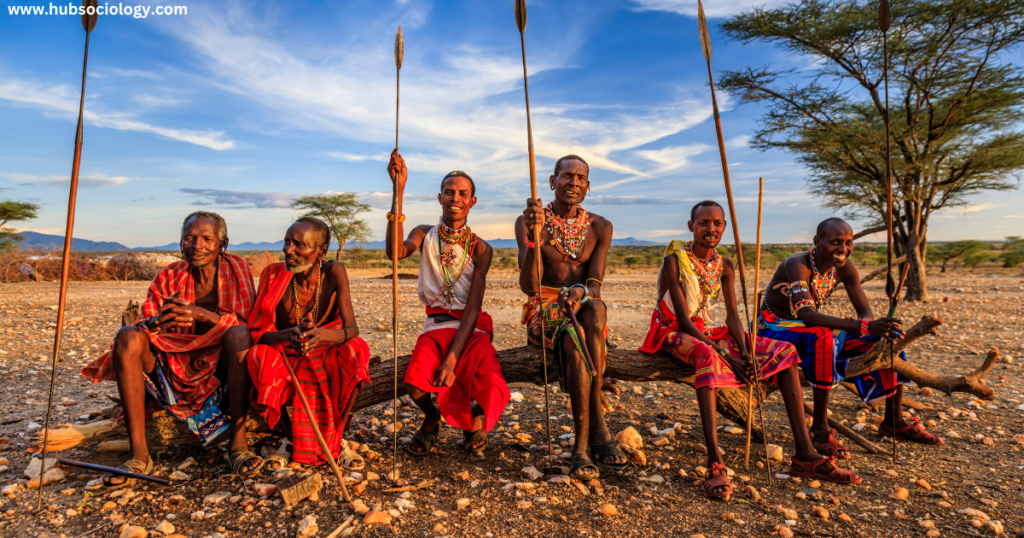Introduction on Kinship Groups
Kinship is one of the fundamental organizing principles in human societies, shaping social structures, inheritance, marriage systems, and political alliances. Among the various forms of kinship groups, lineage, clan, and moiety play crucial roles in defining social relationships, descent patterns, and group solidarity. These kinship structures vary across cultures but share common features in terms of descent, exogamy, and social organization.

This article explores the sociological aspects of lineage, clan, and moiety, examining their definitions, functions, and significance in different societies. By analyzing these kinship groups, we can better understand how human societies organize themselves around principles of descent and affiliation.
1. Lineage: Descent-Based Kinship Groups
Definition and Characteristics
A lineage is a unilineal descent group where members trace their ancestry to a common progenitor through either the male line (patrilineage) or the female line (matrilineage). Lineages are often corporate groups, meaning they hold collective property, political power, and ritual responsibilities.
Key features of lineage include:
- Unilineal descent: Members trace kinship through one line (father’s or mother’s side).
- Genealogical depth: Lineages typically extend over several generations, with a known ancestor.
- Corporate functions: Lineages may control land, organize religious ceremonies, and regulate marriages.
Types of Lineage
- Patrilineage: Descent is traced through the male line (e.g., among the Nuer of South Sudan).
- Matrilineage: Descent is traced through the female line (e.g., the Khasi of India).
Sociological Functions
- Economic role: Lineages often manage land and resources collectively.
- Political organization: In some societies, lineages form the basis of leadership and governance.
- Social identity: Lineages provide individuals with a sense of belonging and status.
2. Clan: Broader Kinship Affiliation
Definition and Characteristics
A clan is a larger kinship group composed of multiple lineages that claim descent from a common, often mythical, ancestor. Unlike lineages, clans may not have precise genealogical connections but share a symbolic kinship.
Key features of clans include:
- Unilineal descent: Like lineages, clans are usually patrilineal or matrilineal.
- Totemic associations: Many clans have symbolic animals, plants, or natural phenomena as emblems.
- Exogamy: Clan members often must marry outside their clan.
Examples of Clans
- Scottish clans: Highland families with shared surnames and territorial affiliations.
- Native American clans: The Iroquois have matrilineal clans like the Bear, Wolf, and Turtle.

Sociological Functions
- Social cohesion: Clans unite people beyond immediate family ties.
- Regulation of marriage: Exogamous rules prevent inbreeding and foster alliances.
- Political alliances: Clans may form alliances for warfare or trade.
3. Moiety: Dual Social Division
Definition and Characteristics
A moiety (from French moitié, meaning “half”) is a kinship system that divides society into two complementary descent groups. Each moiety is exogamous, meaning members must marry someone from the opposite group.
Key features of moieties include:
- Dual organization: Society is split into two halves (e.g., “Eagle” and “Raven” among some Indigenous groups).
- Reciprocal obligations: Moieties often exchange goods, services, and spouses.
- Ceremonial roles: Each moiety may have specific ritual duties.
Examples of Moieties
- Australian Aboriginal societies: Many groups have moieties like Dhuwa and Yirritja.
- Native American tribes: The Hopi have “Summer” and “Winter” moieties.
Sociological Functions
- Balancing social structure: Moieties ensure reciprocity and cooperation.
- Regulating marriage: Exogamous rules maintain social harmony.
- Ritual specialization: Each moiety may perform distinct ceremonial roles.
Comparison of Lineage, Clan, and Moiety
| Feature | Lineage | Clan | Moiety |
|---|---|---|---|
| Descent | Direct genealogical ties | Mythical/common ancestor | Dual division of society |
| Size | Smaller, localized | Larger, dispersed | Society-wide halves |
| Exogamy | Often lineage-exogamous | Clan-exogamous | Moiety-exogamous |
| Function | Economic, political control | Identity, social cohesion | Reciprocity, ritual roles |
Conclusion on Kinship Groups
Lineage, clan, and moiety are essential kinship structures that shape social organization across cultures. While lineages focus on direct descent and corporate functions, clans provide broader affiliation through symbolic ancestry. Moieties, on the other hand, divide societies into two interdependent groups, ensuring reciprocity and exogamy.

Understanding these kinship systems helps sociologists and anthropologists analyze how societies maintain cohesion, regulate marriage, and organize political and economic life. Despite modernization, many indigenous and traditional societies still rely on these kinship structures, demonstrating their enduring significance in human social organization.
Like this this Article ? You Can follow as on :-
Facebook – https://www.facebook.com/hubsociology
Whatsapp Channel – https://whatsapp.com/channel/0029Vb6D8vGKWEKpJpu5QP0O
Gmail – hubsociology@gmail.com
Topic Related Questions on Kinship Groups
5-Mark Questions (Short Answer Type)
- Define lineage and explain its two types.
- What is a clan? Give one example.
- How does a moiety differ from a clan?
- What is the significance of exogamy in kinship groups?
- Name two societies that follow matrilineal descent.
- What are the economic functions of a lineage?
- How do clans contribute to social cohesion?
- Why are totems important in clans?
- What is the role of moieties in marriage regulation?
- Differentiate between patrilineal and matrilineal descent.
10-Mark Questions (Brief Essay Type)
- Explain the concept of lineage in kinship. Discuss its social and economic functions.
- Describe the features of a clan and its role in tribal societies with examples.
- Compare and contrast lineage and clan in terms of structure and function.
- What is a moiety system? Discuss its significance in Aboriginal Australian societies.
- How do kinship groups (lineage, clan, moiety) regulate marriage practices?
- Discuss the political role of lineages in traditional African societies.
- Explain the concept of exogamy with reference to clans and moieties.
- How do kinship structures contribute to identity formation in tribal communities?
- Analyze the role of totems in clan-based societies.
- Why are moieties considered a form of dual organization in kinship?
15-Mark Questions (Long Essay Type)
- Define and discuss the three major kinship groups—lineage, clan, and moiety—with suitable examples.
- Examine the role of kinship in social organization, focusing on lineage, clan, and moiety systems.
- Compare the structural and functional differences between clans and moieties in tribal societies.
- How do kinship groups (lineage, clan, moiety) influence marriage, inheritance, and political systems?
- Discuss the significance of unilineal descent in kinship with reference to lineage and clan systems.
- Analyze the economic, political, and religious functions of kinship groups in traditional societies.
- Why are moieties important in maintaining social balance? Discuss with examples.
- Critically evaluate the impact of modernization on traditional kinship structures.
- How do lineage, clan, and moiety contribute to social solidarity and conflict resolution?
- Discuss the relevance of kinship studies in understanding contemporary tribal societies.

1 thought on “Kinship Groups: Lineage, Clan, and Moiety in Sociological Perspective”